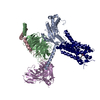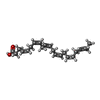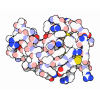+ Open data
Open data
- Basic information
Basic information
| Entry | Database: PDB / ID: 8eit | ||||||||||||||||||||||||||||||||||||||||||||||||||||||
|---|---|---|---|---|---|---|---|---|---|---|---|---|---|---|---|---|---|---|---|---|---|---|---|---|---|---|---|---|---|---|---|---|---|---|---|---|---|---|---|---|---|---|---|---|---|---|---|---|---|---|---|---|---|---|---|
| Title | Structure of FFAR1-Gq complex bound to DHA | ||||||||||||||||||||||||||||||||||||||||||||||||||||||
 Components Components |
| ||||||||||||||||||||||||||||||||||||||||||||||||||||||
 Keywords Keywords | MEMBRANE PROTEIN / FFAR1 / FFAs / diabetes / CryoEM | ||||||||||||||||||||||||||||||||||||||||||||||||||||||
| Function / homology |  Function and homology information Function and homology informationbioactive lipid receptor activity / Free fatty acid receptors / Fatty Acids bound to GPR40 (FFAR1) regulate insulin secretion / Synthesis, secretion, and inactivation of Glucose-dependent Insulinotropic Polypeptide (GIP) / response to fatty acid / positive regulation of calcium ion transport / insulin secretion / negative regulation of interleukin-1 beta production / ligand-gated ion channel signaling pathway / viral release from host cell by cytolysis ...bioactive lipid receptor activity / Free fatty acid receptors / Fatty Acids bound to GPR40 (FFAR1) regulate insulin secretion / Synthesis, secretion, and inactivation of Glucose-dependent Insulinotropic Polypeptide (GIP) / response to fatty acid / positive regulation of calcium ion transport / insulin secretion / negative regulation of interleukin-1 beta production / ligand-gated ion channel signaling pathway / viral release from host cell by cytolysis / peptidoglycan catabolic process / positive regulation of insulin secretion / G protein-coupled receptor activity / Olfactory Signaling Pathway / Activation of the phototransduction cascade / G beta:gamma signalling through PLC beta / Presynaptic function of Kainate receptors / Thromboxane signalling through TP receptor / G protein-coupled acetylcholine receptor signaling pathway / cell wall macromolecule catabolic process / Activation of G protein gated Potassium channels / Inhibition of voltage gated Ca2+ channels via Gbeta/gamma subunits / G-protein activation / Prostacyclin signalling through prostacyclin receptor / G beta:gamma signalling through CDC42 / Glucagon signaling in metabolic regulation / G beta:gamma signalling through BTK / Synthesis, secretion, and inactivation of Glucagon-like Peptide-1 (GLP-1) / ADP signalling through P2Y purinoceptor 12 / photoreceptor disc membrane / Sensory perception of sweet, bitter, and umami (glutamate) taste / Glucagon-type ligand receptors / lysozyme / Adrenaline,noradrenaline inhibits insulin secretion / lysozyme activity / Vasopressin regulates renal water homeostasis via Aquaporins / Glucagon-like Peptide-1 (GLP1) regulates insulin secretion / G alpha (z) signalling events / cellular response to catecholamine stimulus / ADP signalling through P2Y purinoceptor 1 / ADORA2B mediated anti-inflammatory cytokines production / G beta:gamma signalling through PI3Kgamma / Cooperation of PDCL (PhLP1) and TRiC/CCT in G-protein beta folding / adenylate cyclase-activating dopamine receptor signaling pathway / GPER1 signaling / glucose homeostasis / G-protein beta-subunit binding / cellular response to prostaglandin E stimulus / Inactivation, recovery and regulation of the phototransduction cascade / heterotrimeric G-protein complex / G alpha (12/13) signalling events / sensory perception of taste / extracellular vesicle / signaling receptor complex adaptor activity / Thrombin signalling through proteinase activated receptors (PARs) / positive regulation of cytosolic calcium ion concentration / retina development in camera-type eye / GTPase binding / Ca2+ pathway / fibroblast proliferation / High laminar flow shear stress activates signaling by PIEZO1 and PECAM1:CDH5:KDR in endothelial cells / G alpha (i) signalling events / G alpha (s) signalling events / phospholipase C-activating G protein-coupled receptor signaling pathway / G alpha (q) signalling events / Ras protein signal transduction / host cell cytoplasm / Extra-nuclear estrogen signaling / cell population proliferation / defense response to bacterium / G protein-coupled receptor signaling pathway / lysosomal membrane / GTPase activity / synapse / lipid binding / protein-containing complex binding / signal transduction / extracellular exosome / membrane / plasma membrane / cytosol / cytoplasm Similarity search - Function | ||||||||||||||||||||||||||||||||||||||||||||||||||||||
| Biological species |  Homo sapiens (human) Homo sapiens (human) Tequatrovirus T4 Tequatrovirus T4 | ||||||||||||||||||||||||||||||||||||||||||||||||||||||
| Method | ELECTRON MICROSCOPY / single particle reconstruction / cryo EM / Resolution: 2.8 Å | ||||||||||||||||||||||||||||||||||||||||||||||||||||||
 Authors Authors | Kumari, P. / Inoue, A. / Chapman, K. / Lian, P. / Rosenbaum, D.M. | ||||||||||||||||||||||||||||||||||||||||||||||||||||||
| Funding support |  United States, 1items United States, 1items
| ||||||||||||||||||||||||||||||||||||||||||||||||||||||
 Citation Citation |  Journal: Proc Natl Acad Sci U S A / Year: 2023 Journal: Proc Natl Acad Sci U S A / Year: 2023Title: Molecular mechanism of fatty acid activation of FFAR1. Authors: Punita Kumari / Asuka Inoue / Karen Chapman / Peng Lian / Daniel M Rosenbaum /   Abstract: FFAR1 is a G-protein-coupled receptor (GPCR) that responds to circulating free fatty acids to enhance glucose-stimulated insulin secretion and release of incretin hormones. Due to the glucose- ...FFAR1 is a G-protein-coupled receptor (GPCR) that responds to circulating free fatty acids to enhance glucose-stimulated insulin secretion and release of incretin hormones. Due to the glucose-lowering effect of FFAR1 activation, potent agonists for this receptor have been developed for the treatment of diabetes. Previous structural and biochemical studies of FFAR1 showed multiple sites of ligand binding to the inactive state but left the mechanism of fatty acid interaction and receptor activation unknown. We used cryo-electron microscopy to elucidate structures of activated FFAR1 bound to a G mimetic, which were induced either by the endogenous FFA ligand docosahexaenoic acid or γ-linolenic acid and the agonist drug TAK-875. Our data identify the orthosteric pocket for fatty acids and show how both endogenous hormones and synthetic agonists induce changes in helical packing along the outside of the receptor that propagate to exposure of the G-protein-coupling site. These structures show how FFAR1 functions without the highly conserved "DRY" and "NPXXY" motifs of class A GPCRs and also illustrate how the orthosteric site of a receptor can be bypassed by membrane-embedded drugs to confer full activation of G protein signaling. | ||||||||||||||||||||||||||||||||||||||||||||||||||||||
| History |
|
- Structure visualization
Structure visualization
| Structure viewer | Molecule:  Molmil Molmil Jmol/JSmol Jmol/JSmol |
|---|
- Downloads & links
Downloads & links
- Download
Download
| PDBx/mmCIF format |  8eit.cif.gz 8eit.cif.gz | 213.9 KB | Display |  PDBx/mmCIF format PDBx/mmCIF format |
|---|---|---|---|---|
| PDB format |  pdb8eit.ent.gz pdb8eit.ent.gz | 160.5 KB | Display |  PDB format PDB format |
| PDBx/mmJSON format |  8eit.json.gz 8eit.json.gz | Tree view |  PDBx/mmJSON format PDBx/mmJSON format | |
| Others |  Other downloads Other downloads |
-Validation report
| Arichive directory |  https://data.pdbj.org/pub/pdb/validation_reports/ei/8eit https://data.pdbj.org/pub/pdb/validation_reports/ei/8eit ftp://data.pdbj.org/pub/pdb/validation_reports/ei/8eit ftp://data.pdbj.org/pub/pdb/validation_reports/ei/8eit | HTTPS FTP |
|---|
-Related structure data
| Related structure data |  28164MC  8ejcC  8ejkC M: map data used to model this data C: citing same article ( |
|---|---|
| Similar structure data | Similarity search - Function & homology  F&H Search F&H Search |
- Links
Links
- Assembly
Assembly
| Deposited unit | 
|
|---|---|
| 1 |
|
- Components
Components
-Protein , 2 types, 2 molecules AR
| #1: Protein | Mass: 27638.461 Da / Num. of mol.: 1 Source method: isolated from a genetically manipulated source Source: (gene. exp.)  Homo sapiens (human) / Cell line (production host): Sf9 / Production host: Homo sapiens (human) / Cell line (production host): Sf9 / Production host:  |
|---|---|
| #5: Protein | Mass: 54298.785 Da / Num. of mol.: 1 Source method: isolated from a genetically manipulated source Source: (gene. exp.)  Tequatrovirus T4, (gene. exp.) Tequatrovirus T4, (gene. exp.)  Homo sapiens (human) Homo sapiens (human)Gene: FFAR1, GPR40 / Cell line (production host): Sf9 / Production host:  |
-Guanine nucleotide-binding protein ... , 2 types, 2 molecules BC
| #2: Protein | Mass: 37416.930 Da / Num. of mol.: 1 Source method: isolated from a genetically manipulated source Source: (gene. exp.)  Homo sapiens (human) / Gene: GNB1 / Cell line (production host): Sf9 / Production host: Homo sapiens (human) / Gene: GNB1 / Cell line (production host): Sf9 / Production host:  |
|---|---|
| #3: Protein | Mass: 9137.474 Da / Num. of mol.: 1 Source method: isolated from a genetically manipulated source Source: (gene. exp.)  Homo sapiens (human) / Gene: GNG2 / Cell line (production host): Sf9 / Production host: Homo sapiens (human) / Gene: GNG2 / Cell line (production host): Sf9 / Production host:  |
-Antibody / Non-polymers , 2 types, 2 molecules E

| #4: Antibody | Mass: 34930.852 Da / Num. of mol.: 1 Source method: isolated from a genetically manipulated source Source: (gene. exp.)  Homo sapiens (human) / Cell line (production host): Sf9 / Production host: Homo sapiens (human) / Cell line (production host): Sf9 / Production host:  |
|---|---|
| #6: Chemical | ChemComp-HXA / |
-Details
| Has ligand of interest | Y |
|---|---|
| Has protein modification | Y |
-Experimental details
-Experiment
| Experiment | Method: ELECTRON MICROSCOPY |
|---|---|
| EM experiment | Aggregation state: PARTICLE / 3D reconstruction method: single particle reconstruction |
- Sample preparation
Sample preparation
| Component | Name: Free Fatty Acid Receptor1- G-Protein complex / Type: COMPLEX / Entity ID: #1-#5 / Source: RECOMBINANT | ||||||||||||||||||||||||||||||
|---|---|---|---|---|---|---|---|---|---|---|---|---|---|---|---|---|---|---|---|---|---|---|---|---|---|---|---|---|---|---|---|
| Molecular weight | Experimental value: NO | ||||||||||||||||||||||||||||||
| Source (natural) | Organism:  Homo sapiens (human) Homo sapiens (human) | ||||||||||||||||||||||||||||||
| Source (recombinant) | Organism:  | ||||||||||||||||||||||||||||||
| Buffer solution | pH: 7.5 | ||||||||||||||||||||||||||||||
| Buffer component |
| ||||||||||||||||||||||||||||||
| Specimen | Conc.: 5 mg/ml / Embedding applied: NO / Shadowing applied: NO / Staining applied: NO / Vitrification applied: YES | ||||||||||||||||||||||||||||||
| Vitrification | Instrument: FEI VITROBOT MARK IV / Cryogen name: ETHANE |
- Electron microscopy imaging
Electron microscopy imaging
| Experimental equipment |  Model: Titan Krios / Image courtesy: FEI Company |
|---|---|
| Microscopy | Model: FEI TITAN KRIOS |
| Electron gun | Electron source:  FIELD EMISSION GUN / Accelerating voltage: 300 kV / Illumination mode: FLOOD BEAM FIELD EMISSION GUN / Accelerating voltage: 300 kV / Illumination mode: FLOOD BEAM |
| Electron lens | Mode: BRIGHT FIELD / Nominal defocus max: 2400 nm / Nominal defocus min: 1400 nm |
| Image recording | Electron dose: 1.4 e/Å2 / Film or detector model: GATAN K3 BIOQUANTUM (6k x 4k) |
- Processing
Processing
| Software | Name: PHENIX / Version: 1.19.2_4158: / Classification: refinement | ||||||||||||||||||||||||
|---|---|---|---|---|---|---|---|---|---|---|---|---|---|---|---|---|---|---|---|---|---|---|---|---|---|
| EM software |
| ||||||||||||||||||||||||
| CTF correction | Type: PHASE FLIPPING AND AMPLITUDE CORRECTION | ||||||||||||||||||||||||
| Particle selection | Num. of particles selected: 7795974 | ||||||||||||||||||||||||
| 3D reconstruction | Resolution: 2.8 Å / Resolution method: FSC 0.143 CUT-OFF / Num. of particles: 480447 / Symmetry type: POINT | ||||||||||||||||||||||||
| Refine LS restraints |
|
 Movie
Movie Controller
Controller





 PDBj
PDBj
























